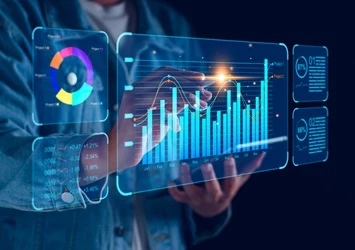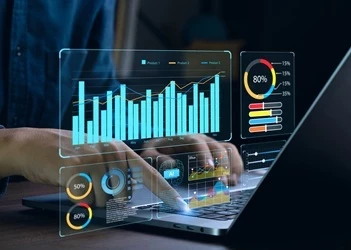Advanced Analytics: How Next-Level Insights Are Shaping the Future of Business
A Look Into How Organizations Are Embracing the Next Generation of Data Analytics
Add bookmark
Advanced Analytics Defined
Advanced analytics (AA) goes beyond traditional business intelligence (BI) and data analytics methods by encompassing mature techniques such as predictive modeling, machine learning and process automation. Through the use of these tools, data scientists and organizations can predict future trends and/or the likelihood of certain events. As Gartner puts it, “Advance Analytics is the autonomous or semi-autonomous examination of data or content using sophisticated techniques and tools, typically beyond those of traditional business intelligence (BI), to discover deeper insights, make predictions, or generate recommendations.”
While classic, descriptive analytics (the systematic computational analysis of data or statistics) and is mainly concerned with characterizing things as they are, AA seeks to project future outcomes and generate recommendations for best courses of action. Similarly, while BI involves the use of software to automate data reporting, it too is mostly concerned with descriptive, here and now insights.
The Benefits of Advanced Analytics
Over the next decade, AA will play an increasingly large role in determining which organizations thrive and which sink into oblivion. Companies who seek to dominate the global digital economy in years to come, such as Amazon and Apple, are already investing massive amounts of resources into AA tools and infrastructure. In fact, the global market for advanced analytics is expected to grow from $248.0 billion in 2019 to $281.0 billion by 2024, with big data and predictive analytics making especially significant gains.
However, even smaller companies can leverage advanced analytics to enhance decision making and boost competitive advantage now as well as for years to come. After all, advanced analytics use cases and applications are incredibly vast.
From more accurately predicting the likelihood of natural disasters to simulating and optimizing manufacturing environments, the ways in which AA can and are being utilized differ significantly from one organization to the next. Below is just a high-level, sampling of how organizations of all types and sizes are benefitting from AA:
- Delivers more refined, detailed and accurate insights that enhance day-to-day business decision making
- Accererates hypothesis and prototyping through improved simulation and testing
- Promotes data democratization and the creation of citizen data scientists
- Improves the efficiency of data science-related processes
- Enables to identification and exploitation of data monetization schemes
- Helps organizations better identify and address threats such as security breaches
- Boosts agility by enabling organizations to predict and proactively respond to future events
- Access to crucial, evidence-driven guidance in times of chance and uncertainty
- Delivers increased visibility and transparency into business operations
- Unlocks new areas of cost reduction and increased profitability
- Provides a foundation for machine learning and artificial intelligence development
Types of Augmented Analytics
Machine Learning Analytics
Artificial intelligence (AI) refers to a constellation of theories, technologies and research surrounding the simulation of human intelligence processes by computer algorithms. The goals of AI usually fall under one of three categories: to build systems that think the same way that humans do; to complete a job successfully but not necessarily recreate human thought; or, using human reasoning as a model but not as the ultimate goal.
Machine Learning (ML), a branch of AI, is the science of getting computers to learn from experience and perform tasks automatically. ML algorithms simulate the learning process by automating the analytical modeling processes, analyzing its output, and progressively updating the model to increase its accuracy.
In other words, machine learning typically works by combining large amounts of data with fast, iterative processing and intelligent algorithms, allowing the software to learn automatically from patterns or features in the data.Some examples of ML applications include:
- Uncovering patterns in market research
- Flagging errors in transactions or data entry
- Predictive text message suggestions on our phones and automated subtitles on videos
- Personalized shopper experience based on browsing history
- Signal anomalies in medical research
Automated machine learning tools such as DataRobot and SAS leverage AI and ML to automate data modeling workflows, dramatically increasing the speed at which individual model attributes can be applied and tested.
Predictive Analytics
Predictive analytics (PA) Is a type of statistical modeling in which computers are able to forecast unknown future events based on historical data. It encompasses a variety of statistical techniques (such as ML, predictive modeling and data mining) and leverages statistics (both historical and current) to estimate, or ‘predict’, future outcomes.
Using PA, companies can more effectively anticipate and proactively plan for future events. For example, Nike uses predictive analytics to forecast customer demand on a hyper-local level. This helps Nike stores optimize their inventory accordingly and develop more targeted marketing campaigns.

"Predictive Analytics Workflow" image sourced from https://www.mathworks.com/discovery/predictive-analytics.html
Predictive analytics is often confused with regression analysis, a statistical technique used to determine the strength and character of the relationship between one dependent variable (usually denoted by Y) and a series of other variables (known as independent variables). For example, the price of a used car given its mileage, brand and/or other variable conditions.
However, it is the combination of statistical techniques such as regression analysis with advanced computing technologies such as ML or that defines predictive analytics.
"AI 101: What is Predictive Analytics? | Accenture" sourced from https://youtu.be/GO8Cd2eUTVE
According to the experts at IBM, 5 prevalent predictive analytics models are:
Classification Models
Classification models are categorized under supervised machine learning models. They place data into categories based on conclusions from the historical data. This model is commonly used for answering questions with binary outputs, such answering yes or no or true and false. Types of classification models include logistic regression, decision trees, random forest, neural networks, and Naïve Bayes.
Clustering Models
Categorized under unsupervised learning, clustering models sort multivariate data into groups based on similar attributes. For example, investment advisors use this technique to build more diversified portfolios. Stocks that exhibit high correlations in returns fall into one basket, those slightly less correlated in another, and so on, until each stock is placed into a category. A marketer might segment customers into groups based on age, location or past purchasing history so that they can build targeted ad campaigns for each cluster. Common clustering algorithms include k-means clustering, mean-shift clustering, density-based spatial clustering of applications with noise (DBSCAN), expectation-maximization (EM) clustering using Gaussian Mixture Models (GMM), and hierarchical clustering.
Forecast Models
The most well-known application of predictive analytics, forecasting uses data mining and probability to forecast or estimate granular, specific outcomes based on historical data. For example, a sales team might use this technique to predict how likely a certain customer is to buy a certain product.
Outliers Models
An outlier is an observation that diverges from an overall pattern on a sample. Outlier models identify and “deal with” such anomalous data entries. Fraud detection systems leverage these methods to identify data irregularities that are consistent with nefarious activity such as suspicious IP addresses or user behavior.
Time-Series Models
A subset of forecasting analytics, time-series models employ a sequence of data points using time as the input parameter. This technique involves analyzing time-based data (years, days, hours, minutes) to foresee future activity and derive hidden insights that inform decision-making.
For example, airlines use time series forecasting models to identify peak travel times, anticipate flight volumes and schedule flights accordingly.
Prescriptive Analytics
Instead of “what did happen” or “what will happen,” prescriptive analytics reveal “what should happen.” It goes one step beyond predictive analytics by applying a combination of machine learning, business rules, artificial intelligence, and algorithms to simulate various approaches to numerous potential outcomes. In another words, prescriptive analytics provide users with a recommended course of action based on informed simulations.
One common application of this technology is Google maps. Using this approach, Google maps not only predicts how long a trip will take based on traffic and driving conditions, it also suggests the optimal route.
CVS health also leverages prescriptive analytics in their Transform Diabetes Care platform, a new tool designed to boost health outcomes for diabetes sufferers. This tool not only helps diabetes patients track their medication and habits, it also provides them with personalized recommendations based on their individual habits and behaviors.
Data & Text Mining
Data mining (DM) is the practice of automatically searching large stores of data to discover patterns and trends that go beyond simple analysis. Using software to look for patterns in large batches of data, the goal of DM is to transform raw data into useful information. It can be used in a variety of ways, such as database marketing, credit risk management, fraud detection, spam Email filtering, or even to discern the sentiment or opinion of user
While data mining handles structured data – highly formatted data such as in databases or ERP systems, text mining deals with unstructured textual data - text that is not pre-defined or organized in any way such as in social media feeds, emails or customer reviews. Using deep learning algorithms such as Naïve Bayes and Support Vector Machines (SVM), and other deep learning algorithms, TM can scan through massive amounts of unstructured textual data, identifying facts, relationships and assertions that would otherwise remain buried. Once extracted, this information is converted into a structured form that can be further analyzed, or presented directly using clustered HTML tables, mind maps, charts, etc.
One major component of TM is semantic analysis, a process that allows computers to understand and interpret sentences, paragraphs, or whole documents, by analyzing their grammatical structure, and identifying relationships between individual words in a particular context. It works by “feeding” machine learning algorithms samples of text to train them to identify intent, classify queries based on topic and extract meaningful information from unstructured data.
Natural language processing (NLP), uses semantic analysis as well as artificial intelligence, and data science to enable computers to understand human language in both written and verbal forms. NLP tools also frequently leverage a process known as sentiment analysis (or opinion mining) to determine whether data is positive, negative or neutral. This enables text mining applications not only “read” text, but understand meaning as well.

*"Comparing data mining and text mining" chart sourced from https://blogs.opentext.com/whats-the-difference-between-data-mining-and-text-mining/
Big Data Analytics
A term that is frequently misused and misunderstood, big data refers to massive complex structured and unstructured data sets that are rapidly generated and transmitted from a wide variety of sources. It refers to data sets that are so large in size, complex and fast moving that cannot be stored or processed by traditional data analytics and management tools.
For example, an example of big data would be the 500+terabytes of new data Facebooks databases ingest per day generated by the trillions of images, comments and videos posted to the site. Or the 20+ petabytes of data Google processes per day across its massive computing clusters.
Big data analytics describes the process of using advanced analytics techniques —like clustering and data mining— to uncover trends, patterns, and correlations in large amounts of raw data to help make data-informed decisions. The analytical techniques are similar, but, due the size of the data sets, highly specialized software backed by powerful cloud-based computing systems are required to process, manage and analyze the data.
Big data analytics are frequently leveraged by financial services organizations looking to mine massive amounts of stock market data to identify and capitalize off of previously unknown trends. Public health organizations are also increasingly leveraging huge amounts of population health data to develop better policies, treatment and healthcare practices.
A concept closely related to BGDA is High Performance Data Analytics (HPDA) which refers to the confluence of high performance computing (HPC) combined with advanced analytics to discover patterns and insights. In other words, it represents that next step for AA and BGDA.
Though not widely adopted yet, high performance analytics is expected to gain prominence over the next few years as HPC becomes more widespread and affordable. In fact, according to a report by Mordor Intelligence, the HPDA market is expected to grow from $48.28 billion in 2020 to $187.57 billion in 2026, registering a CAGR of 25.4%.
Other examples of advanced analytics include:
- Pattern matching - the process of checking whether a specific sequence of characters/tokens/data exists among the given data.
- Visualization - the graphical representation of information and data.
- Multivariate statistics - refers to multiple advanced techniques for examining relationships among multiple variables at the same time. Cluster analysis and data mining, for example, falls into this category.
- Graph analysis - a subset of HPDA, its the process of analyzing data in a graph format using data points as nodes and relationships as edges. As the goal is to discover and explore relationships among entities such as customers, products, operations, and devices, it is commonly used for analyzing large-scale social media activity.
- Simulation Analytics- referenced before in the section on prescriptive analytics, simulation analytics aims to model alternative outcomes and scenarios, before, during and after process implementation and execution.
- Complex event processing (CEP) - is a set of techniques for capturing and analyzing streams of data as they arrive to identify opportunities or threats in real time. CEP uses pattern matching to identify what is happening and provide insight on how to respond. CEP is often used for, according to Gartner “highly demanding, continuous-intelligence applications that enhance situation awareness and support real-time decisions.” For example, stock market trading tools frequently leverage CEP as do military and battlefield applications.
- Cohort analysis - a subset of behavioral analytics that takes the data from one place (i.e. database, web application, enterprise platform) and rather than looking at all users as one unit, it breaks them into related groups for analysis. CA is often used for UX testing and customer retention analysis as it helps data scientists separate growth metrics from engagement metrics as growth can easily mask user dropoff. Studying the spending trends of cohorts from different based on when they joined the site can indicate whether the quality of the average customer being acquired is increasing or decreasing over time.
- Streaming Analytics - Rapidly analyzes high-bandwidth and high-throughput streaming data continuously in real-time rather than in batches
Have 5 minutes? Tell us about your advanced analytics approach via our short, anonymous survey.
Create your own user feedback survey






























